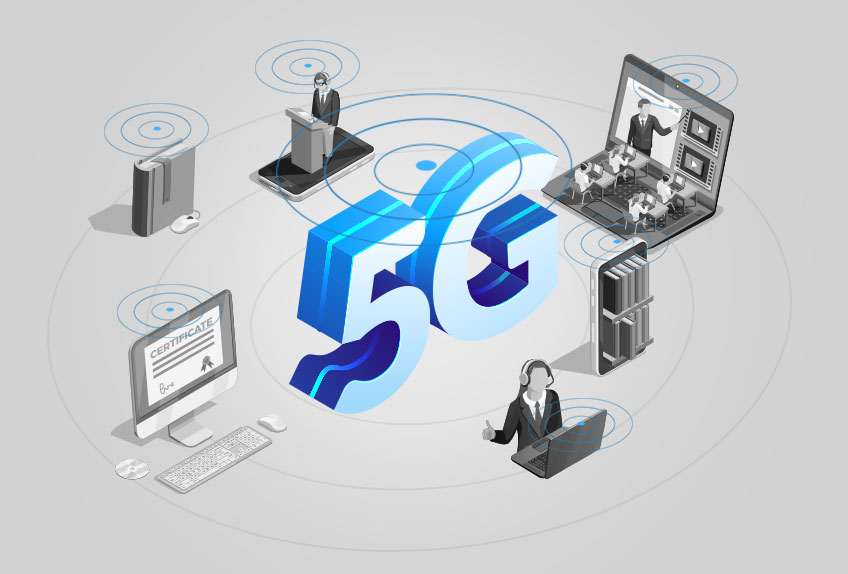The 5th Generation of Education
Reading v/s experiencing. Imagining v/s visualizing. Boring v/s immersive. The future of connectivity – 5G technology – promises to bring in a new era of learning and the education sector is primed to leverage the possibilities that come along with it. The depth and impact of 5G in education will only increase with time, and at higher levels of learning, implementing 5G based education systems will be the core differentiator between the best and the pack.
Several companies are already building their own private 5G networks, we can certainly expect this trend to enter the education ecosystem as well. 5G led systems also present us with the unique possibility of bridging the gap between various educational facilities. Whether institutions choose a collaborative or competitive approach, there’s no doubt that 5G technology will have an immeasurable impact on the education sector in ways we’ve only ever seen in Sci-Fi.
Ed-Tech Possibilities with 5G
Education technology is on the rise and growing faster than ever before. With a meteoric rise in online learning platforms and digital certifications, 5G is poised to enter the market at the right time to further boost its growth. However, these platforms are more relevant at higher levels and for working professionals. But when it comes to an on-campus experience for young students, the possibilities are truly endless.
- Immersive AR & VR classrooms – Be it a working model of the human body or the inner gear movements of complicated machinery, AR & VR technology allows for an immersive classroom with a rich learning environment. The same is true for field trips and site visits, especially with projects like the Smithsonian augmented reality experience. This also allows students to present their projects in more immersive manners with fields such as architecture and engineering benefiting hugely from a shift into the AR/VR scape.
- An Integrated On-Campus Experience – A college/university campus is huge and has the occasional connectivity dead spot. Not only will 5G help negate these issues, but it will also allow for a more interconnected campus experience which greatly bolsters the safety and productivity of all students and faculty on-site.
- Integration of IoT & Robotics – IoT and 5G will greatly reduce the load on tutors and educators by automating a majority of their administrative duties. Most of these integrations will allow for better, more robust learning experiences as tutors will have more time to spend with their students. But the ball doesn’t stop there. Robotics has its own place in the classroom as teaching material and this comes to life in Finland where Elias, a robot who understands multiple languages, adds a whole new dimension to learning by bringing in fun games into the classroom.
- Learning On The Go – As the number of devices increases in our lives, so do our opportunities to use these to learn. Today, a simple walk in the park can become a botany lesson. Whether you’re traveling or stuck at home, accessing your classroom notes, lectures, and lessons is now possible with the tap of a button. Study sessions and group assignments will allow for more collaborative experiences even if students are not in the same physical space which presents itself with exciting possibilities of international collaborations from a young age.
- The technology addresses special needs students – Students with learning difficulties can leverage 5G technology to aid them with their learning difficulties. Tutors for special needs students can also utilise these assistive technologies to enhance their teaching capabilities as well. These technologies will act as an equalizer for students and fusing 5G and IoT into this will further the educational value derived by these students.
Creating a 5G Ecosystem at Educational Institutions
To sum it all up, education can now come to you instead of you physically going to seek it out. Today, we can actually visit the ice age (virtually) or the moon or any of the planets. We can even travel inside the human body to look at how our cells work together or explore entire cities and cultures by immersing ourselves in that environment. These innovations are exciting and promise to give rise to a new generation of youngsters who are smarter, clever, and much more imaginative than ever before.
However, adopting and implementing 5G comes with its own challenges. This is why several institutions are leveraging Distributed Antenna Systems (DAS) and Small Cell technologies in order to build a cohesive communications infrastructure. We at Kaytech Coverage specialize in creating such systems and our team of experienced network professionals will ensure round-the-clock connectivity so you can leverage IoT and the exciting tech possibilities of today and the future.


